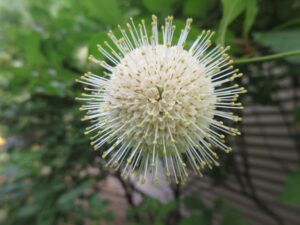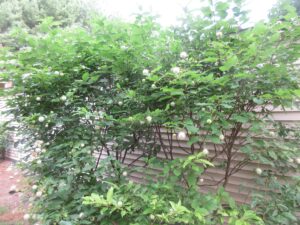Fast-Growing Button Bush

Button Bush Flower
By Glen Wunderlich
I got these plants from the Shiawassee County Conservation District (Mid-Michigan) and found them to be prolific in growth. They grow fast and large and attract pollinators. Seeds from the flowers can be used for propagation, but the stems can also be planted in soil to start your own.
Buttonbush (Cephalanthus occidentalis) is a hardy deciduous shrub used for beauty and functionality. Buttonbush is a fast grower characterized by its round, white, spiky flowers and fragrant aroma. Buttonbush grows best in wetlands or near rivers and is often used to prevent erosion. The shrub requires full sun but may tolerate some shade. Otherwise, buttonbush is extremely resilient in all types of temperatures and conditions. It is important to note that the leaves of this plant are toxic to humans.1

| Common Name | Buttonbush, common buttonbush, honeybells, pond dogwood, swampwood |
| Botanical Name | Cephalanthus occidentalis |
| Family | Rubiaceae |
| Plant Type | Perennial, shrub |
| Mature Size | 6-12 ft. tall, 6-12 ft. wide |
| Sun Exposure | Full, partial |
| Soil Type | Loamy, silt, moist |
| Soil pH | Neutral |
| Bloom Time | Summer |
| Flower Color | White |
| Hardiness Zones | 5-11 (USDA) |
| Native Area | North America |
| Toxicity | Toxic to humans1 |
Buttonbush Care
Here are the main care requirements for growing buttonbush:
- Plant in full or partial sun though the shrub will thrive in six to eight hours of sun a day.
- Aim to keep the soil moist at all times, especially if the bush is in full sun.
- Avoid alkaline soil and plant buttonbush in soil that is neutral to slightly acidic with a soil pH level of 6.8 to 7.2.
- Feed the bush in the spring with a slow-release fertilizer.






